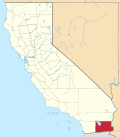- Los Angeles – Located 12 miles southeast of Cahuenga Station in the pueblo of Los Angeles. The 2nd Division headquarters was in a brick building, consisting of an office, blacksmith shop, stables and sheds.
- Monte – Located 13 miles east of Los Angeles.
- Rancho San Jose – Located 12 miles east of Monte in present-day Pomona.
- Rancho Santa Ana del Chino – Located 12 miles southeast of Rancho San Jose.
- Temescal Station – Located 20 miles southeast of Rancho Santa Ana del Chino.
- Laguna Grande Station – Located 10 miles southeast of Temescal Station, near present-day Lake Elsinore.
- Alamos or Willow Springs Station – a later station, 11 miles south of Laguna Grande Station.
- Temecula Station – Located 21 miles southeast of Laguna Grande Station.
- Tejungo Station – Located 14 miles east of Temecula Station, near Aguanga
- Oak Grove Stage Station – Located 12 miles southeast of Tejungo Station.
- Warner's Ranch – Located 10 miles southeast of Oak Grove Station.
- San Felipe Station – Located 10 miles southeast of Warner's Ranch, northwest of nearby Scissors Crossing.
- Vallecito Station – Located 18 miles southeast of San Felipe Station.
- Palm Spring Station – Located 9 miles southeast of Vallecito Station at Palm Spring.
- Carrizo Creek Station – Located 9 miles east southeast of Palm Spring Station.
- Sackett's Wells – a later station, located 171⁄2 miles east southeast of Carrizo Creek Station, 15 miles west northwest of Indian Wells.
- Indian Wells Station – Located 32 miles southeast of Carisso Creek, near present day Heber, no water except at station.
- New River Station – a later station, located 15 miles southeast of Indian Wells Station, in Baja California, 14 miles west of Alamo Mocho Station, in present day Mexicali.
- Alamo Mocho Station – Located south of the Mexican border in Baja California, 38 miles east of Indian Wells Station, no water except at station.
- Gardner's Wells Station – a later station, located south of the Mexican border in Baja California, 9 miles east of Alamo Mocho and 9 miles west of Seven Wells.
- Salt or Seven Wells – a later well, located south of the Mexican border in Baja California, 18 miles east of Alamo Mucho.
- Cooke's Wells Station – Located south of the Mexican border in Baja California, 22 miles east of Alamo Mocho Station, no water except at station.
- Pilot Knob Station – Located 18 miles east of Cooke's Wells.
- Fort Yuma Station – Located 10 miles east of Pilot Knob Station.
Source: "List of Butterfield Overland Mail Stations "Itinerary of the Route"" (PDF). New York Times. October 14, 1858. |
